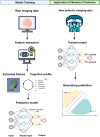Machine learning-based radiomics in neurodegenerative and cerebrovascular disease
- PMID: 39473906
- PMCID: PMC11518692
- DOI: 10.1002/mco2.778
Machine learning-based radiomics in neurodegenerative and cerebrovascular disease
Abstract
Cognitive impairments, which can be caused by neurodegenerative and cerebrovascular disease, represent a growing global health crisis with far-reaching implications for individuals, families, healthcare systems, and economies worldwide. Notably, neurodegenerative-induced cognitive impairment often presents a different pattern and severity compared to cerebrovascular-induced cognitive impairment. With the development of computational technology, machine learning techniques have developed rapidly, which offers a powerful tool in radiomic analysis, allowing a more comprehensive model that can handle high-dimensional, multivariate data compared to the traditional approach. Such models allow the prediction of the disease development, as well as accurately classify disease from overlapping symptoms, therefore facilitating clinical decision making. This review will focus on the application of machine learning-based radiomics on cognitive impairment caused by neurogenerative and cerebrovascular disease. Within the neurodegenerative category, this review primarily focuses on Alzheimer's disease, while also covering other conditions such as Parkinson's disease, Lewy body dementia, and Huntington's disease. In the cerebrovascular category, we concentrate on poststroke cognitive impairment, including ischemic and hemorrhagic stroke, with additional attention given to small vessel disease and moyamoya disease. We also review the specific challenges and limitations when applying machine learning radiomics, and provide our suggestion to overcome those limitations towards the end, and discuss what could be done for future clinical use.
Keywords: machine learning; neuroimaging; poststroke cognitive impairment; radiomics; stroke.
© 2024 The Author(s). MedComm published by Sichuan International Medical Exchange & Promotion Association (SCIMEA) and John Wiley & Sons Australia, Ltd.
Conflict of interest statement
The authors declare they have no conflict of interest.
Figures





Similar articles
-
The future of Cochrane Neonatal.Early Hum Dev. 2020 Nov;150:105191. doi: 10.1016/j.earlhumdev.2020.105191. Epub 2020 Sep 12. Early Hum Dev. 2020. PMID: 33036834
-
Cognitive impairment in Parkinson's disease is multifactorial: A neuropsychological study.Acta Neurol Scand. 2020 Jun;141(6):500-508. doi: 10.1111/ane.13226. Epub 2020 Feb 27. Acta Neurol Scand. 2020. PMID: 32002988
-
Individualized Prediction of Early Alzheimer's Disease Based on Magnetic Resonance Imaging Radiomics, Clinical, and Laboratory Examinations: A 60-Month Follow-Up Study.J Magn Reson Imaging. 2021 Nov;54(5):1647-1657. doi: 10.1002/jmri.27689. Epub 2021 May 13. J Magn Reson Imaging. 2021. PMID: 33987915 Clinical Trial.
-
Machine learning methods for predicting progression from mild cognitive impairment to Alzheimer's disease dementia: a systematic review.Alzheimers Res Ther. 2021 Sep 28;13(1):162. doi: 10.1186/s13195-021-00900-w. Alzheimers Res Ther. 2021. PMID: 34583745 Free PMC article.
-
MRI Radiomics Classification and Prediction in Alzheimer's Disease and Mild Cognitive Impairment: A Review.Curr Alzheimer Res. 2020;17(3):297-309. doi: 10.2174/1567205017666200303105016. Curr Alzheimer Res. 2020. PMID: 32124697 Review.
Cited by
-
Development of a Diagnostic Prediction Model for Post-Stroke Cognitive Impairment in Acute Large Vessel Occlusion Stroke Using Multimodal MRI and PET/CT: A Study Protocol.Brain Behav. 2025 Jun;15(6):e70613. doi: 10.1002/brb3.70613. Brain Behav. 2025. PMID: 40495418 Free PMC article.
-
Research progress of artificial intelligence in moyamoya disease.Front Neurol. 2025 May 16;16:1581338. doi: 10.3389/fneur.2025.1581338. eCollection 2025. Front Neurol. 2025. PMID: 40452760 Free PMC article. Review.
-
Comparison of Radiomics and conventional SUVr methods for Alzheimer's disease classification using AV45 PET imaging.Front Neurol. 2025 Aug 6;16:1594470. doi: 10.3389/fneur.2025.1594470. eCollection 2025. Front Neurol. 2025. PMID: 40843268 Free PMC article.
-
Neuroimaging and machine learning in eating disorders: a systematic review.Eat Weight Disord. 2025 Jun 1;30(1):46. doi: 10.1007/s40519-025-01757-w. Eat Weight Disord. 2025. PMID: 40450619 Free PMC article. Review.
-
Developments in MRI radiomics research for vascular cognitive impairment.Insights Imaging. 2025 Jul 1;16(1):146. doi: 10.1186/s13244-025-02026-1. Insights Imaging. 2025. PMID: 40593438 Free PMC article. Review.
References
-
- Rost NS, Brodtmann A, Pase MP, et al. Post‐stroke cognitive impairment and dementia. Circ Res. 2022;130(8):1252‐1271. - PubMed
-
- Hu HY, Ou YN, Shen XN, et al. White matter hyperintensities and risks of cognitive impairment and dementia: a systematic review and meta‐analysis of 36 prospective studies. Neurosci Biobehav Rev. 2021;120:16‐27. - PubMed
Publication types
LinkOut - more resources
Full Text Sources
